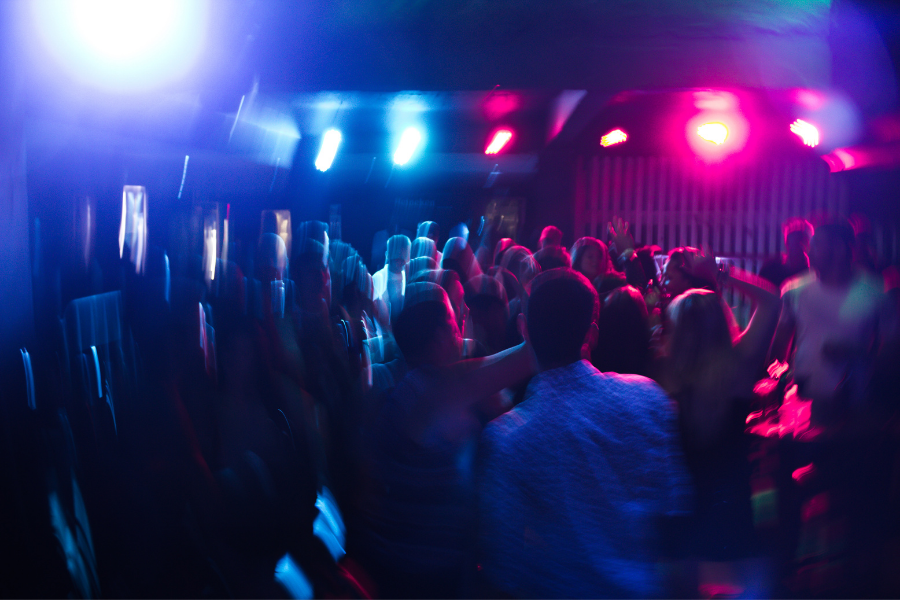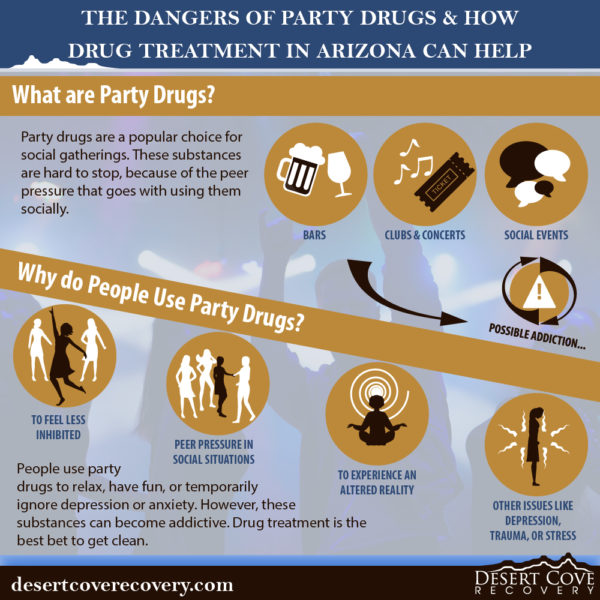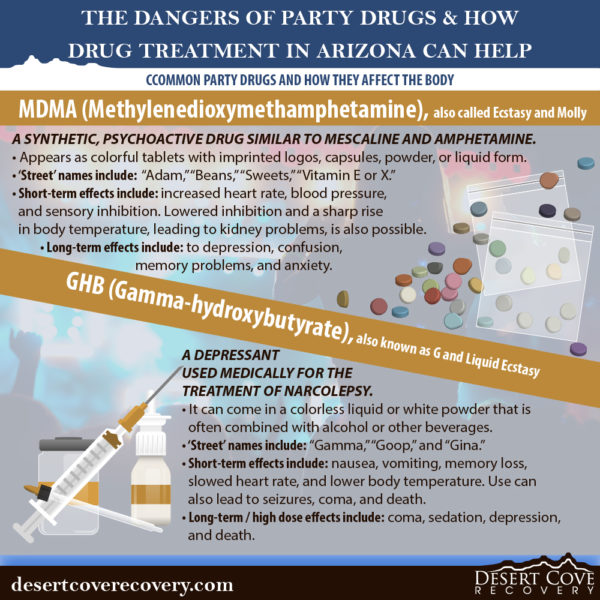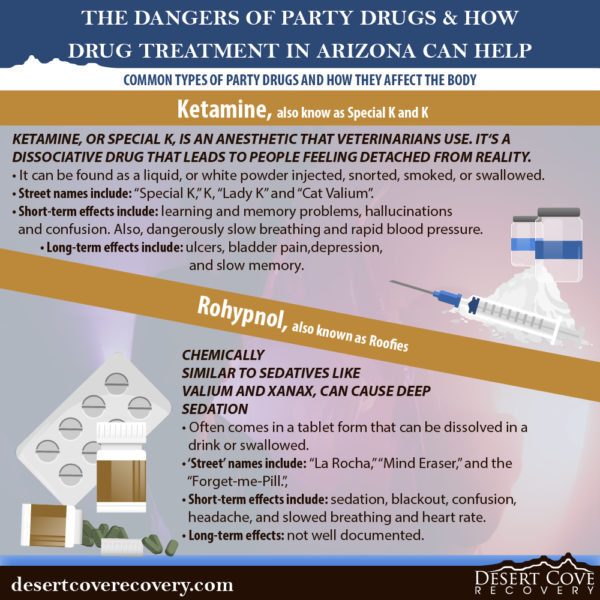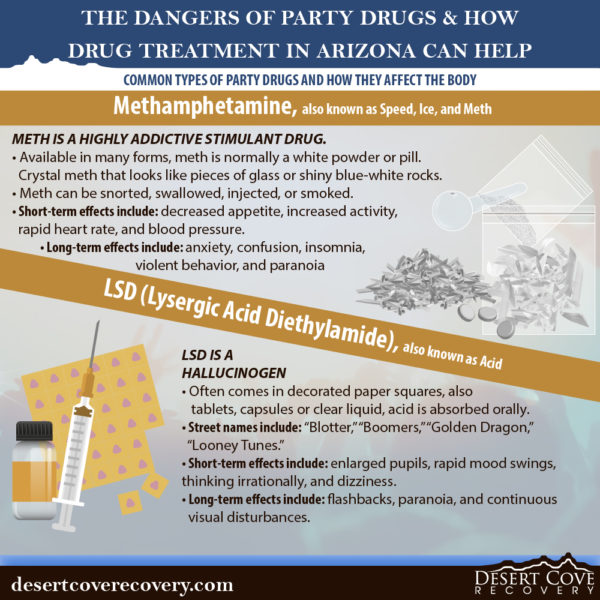Party drugs are popular because people do them socially at clubs, bars, concerts, or while out socializing to lose their inhibitions, get out of their head, and have more energy. It can be challenging to stop using these drugs because people do them when they’re with others, and the influence of peer pressure can be intense. Unfortunately, this is also why party drugs can lead to long-term substance use problems. We’ll examine some common party drugs in detail, and conclude by looking at how drug treatment in Arizona can help.
What are Party Drugs?
Party drugs are also referred to as club drugs. They are psychoactive drugs that act on the central nervous system.1 They can lead to mood and behavior changes and impact reaction times and awareness of a person’s surroundings.
Why do People Use Party Drugs?
People use party drugs for several reasons:
- To feel less inhibited
- Peer pressure in social situations
- To experience an altered reality
- To deal with other issues like depression, trauma, or stress
Whatever the reason a person uses them, party drugs can become addictive, just like any other class of drugs or alcohol. Seeking drug treatment in Arizona for these drugs is often the only way to stop using them.
Different Types of Party Drugs and Whether They Need Drug Treatment Help
There are several drugs that fall under the party drug umbrella. Each one is dangerous in its own right and impacts the body differently. Here’s a rundown of the most common types of party drugs and how they affect the body: 2
MDMA (Methylenedioxymethamphetamine), also called Ecstasy and Molly
- MDMA is a synthetic, psychoactive drug similar to the hallucinogen mescaline and the stimulant amphetamine.
- It’s usually snorted or swallowed.
- It’s also known as “Adam,” “Beans,” “Sweets,” “Vitamin E or X.”
- It can come in colorful tablets with imprinted logos, capsules, powder, or liquid form.
- Short-term impact includes increased heart rate, blood pressure, and sensory inhibition. Lowered inhibition and a sharp rise in body temperature, leading to kidney problems, are also possible.
- Long-term use can lead to depression, confusion, memory problems, and anxiety.
GHB (Gamma-hydroxybutyrate), also known as G and Liquid Ecstasy
- GHB is a depressant that is medically used to treat narcolepsy.
- It can come in a colorless liquid or white powder that is often combined with alcohol or other beverages.
- Popular street names include “Gamma,” “Goop,” and “Gina.”
- Short-term effects include nausea, vomiting, memory loss, slowed heart rate, and lower body temperature. Use can also lead to seizures, coma, and death.
- High doses of GHB can result in coma, sedation, depression, and even death.3
Ketamine, also known as Special K and K
- Ketamine, or Special K, is an anesthetic that veterinarians use. It‘s a dissociative drug that leads to people feeling detached from reality.
- It can be found as a liquid, or white powder injected, snorted, smoked, or swallowed.
- Besides “Special K,” Ketamine is also known as “Lady K” and “Cat Valium.”
- Short-term impact includes learning and memory problems and hallucinations, and confusion.
- Use can also lead to dangerously slow breathing and rapid blood pressure.
- Long-term use can lead to ulcers and bladder pain and depression, and slow memory.
- Ketamine can also be used as a date rape drug.
Rohypnol, also known as Roofies
- Rohypnol is chemically similar to sedatives like Valium and Xanax. It’s often used by people committing sexual assaults because it can lead to deep sedation.
- It often comes in a tablet form that can be dissolved in a drink or swallowed.
- It’s also known as “La Rocha,” “Mind Eraser,” and the “Forget-me-Pill,” among other names.
- While long-term effects are not documented, short-term effects include sedation, blackout, confusion, headache, and slowed breathing and heart rate.
Methamphetamine, also known as Speed, Ice, and Meth
- This class of party drugs is a highly addictive stimulant drug.
- It comes in many forms, like a white powder or pill. There is also crystal meth that looks like pieces of glass or shiny blue-white rocks.
- Meth can be snorted, swallowed, injected, or smoked.
- Short-term use leads to decreased appetite, increased activity, rapid heart rate, and blood pressure.
- Anxiety, confusion, insomnia, violent behavior, and paranoia can set in in the long term.
LSD (Lysergic Acid Diethylamide), also known as Acid
- LSD is a hallucinogen that is made from lysergic acid.
- Acid can be swallowed or absorbed through mouth paper squares.
- It can come in a tablet, capsule, clear liquid, or decorated paper squares.
- Common names include “Blotter,” “Boomers,” “Golden Dragon,” and “Looney Tunes.”
- Enlarged pupils, rapid mood swings, thinking irrationally, and dizziness are among the short-term effects.
- Flashbacks, paranoia, and continuous visual disturbances are potential long-term effects.
How Drug Treatment in Arizona Can Help with Party Drug Addiction
At Desert Cove Recovery, we know that it can be difficult for people to stop using these party drugs on their own. We offer treatment to help detox the body and help people live without the drug they have become so dependent on using. For more information on our drug treatment programs, call us or reach out to us online. Let us help you live a sober life.
Sources:
[1] https://medlineplus.gov/clubdrugs.html
[2] https://www.drugabuse.gov/drug-topics/commonly-used-drugs-charts#mdma-ecstasy-molly-
[3] https://www.drugs.com/illicit/ghb.html

